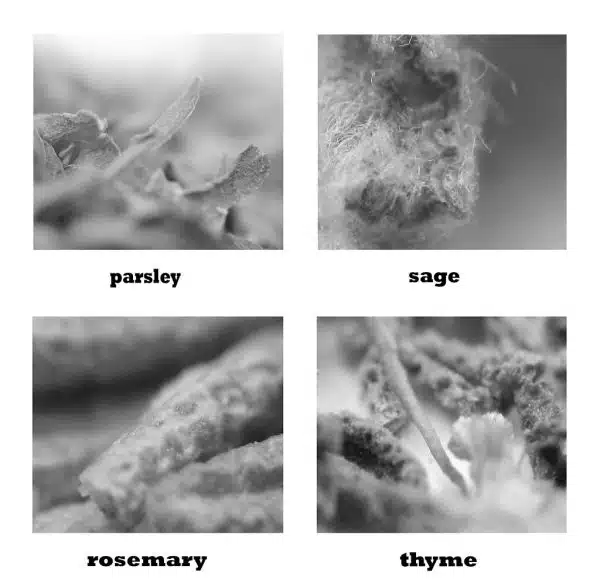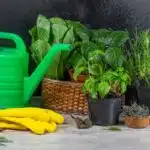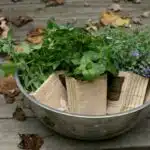Thyme is a versatile herb that is not only a great addition to many culinary dishes but also has numerous health benefits. Growing thyme indoors can be an excellent way to have fresh herbs readily available for your cooking needs, and it’s a great way to add some greenery to your home. Indoor gardening may seem daunting, but with the right techniques and tools, growing thyme indoors can be a fun and rewarding experience.
As an indoor herb gardening expert, I have seen firsthand how growing herbs indoors can bring a sense of fulfillment and purpose to people’s lives. Thyme is one of my favorite herbs to grow because it’s easy to care for and adds a delicious flavor to many different meals. In this article, I will guide you through the process of growing thyme indoors, from choosing the right pot and soil mix to watering and pruning tips. Whether you are an experienced gardener or just starting out, this guide will help you successfully grow thyme in your own home.
Benefits Of Growing Thyme Indoors
According to recent studies, indoor herb gardening has become a popular trend among homeowners. The benefits of growing thyme indoors go beyond just having fresh herbs for cooking. Thyme is known for its medicinal properties and is used in many natural remedies.
One of the benefits of growing thyme indoors is that it is relatively low maintenance. Thyme prefers well-draining soil and does not require frequent watering. In fact, overwatering can cause root rot, so it’s important to let the soil dry out before watering again. Additionally, thyme prefers bright light but can survive in lower light conditions, making it a versatile plant for any home.
Another benefit of growing thyme indoors is that it can be easily harvested year-round. Thyme leaves can be plucked as needed and used fresh or dried for later use. This allows for a constant supply of fresh thyme, which can enhance the flavor of many dishes. Maintenance tips include pruning the plant regularly to encourage growth and prevent overcrowding.
Moving on to choosing the right thyme variety, it’s important to select a variety that will thrive in an indoor environment.
Choosing The Right Thyme Variety
When it comes to growing thyme indoors, choosing the right variety is crucial. While all thyme plants belong to the same genus Thymus, there are several distinct varieties available that differ in their growth habits, flavor profiles, and overall appearance. Some popular thyme varieties for indoor gardening include English thyme, French thyme, lemon thyme, and creeping thyme.
English thyme is a classic variety with a strong aroma and slightly bitter taste. It grows upright and can reach up to 12 inches in height. French thyme, on the other hand, has a milder flavor profile and a more prostrate growth habit. It’s an excellent choice for small containers or hanging baskets. Lemon thyme has a citrusy scent and can be used in both sweet and savory dishes. Lastly, creeping thyme is a low-growing variety that spreads quickly and is ideal for ground cover or as an edging plant.
When selecting the right thyme variety for your indoor garden, it’s essential to consider the growing conditions you can provide. Most varieties require well-draining soil with plenty of sunlight and good air circulation. However, some varieties like lemon thyme prefer partial shade or filtered sunlight. Additionally, make sure to water your plants thoroughly but allow the soil to dry out between waterings to prevent root rot.
In summary, choosing the right thyme variety is key when growing this herb indoors successfully. Consider factors like growth habits and flavor profiles when making your selection. Also, ensure that you can provide the necessary growing conditions such as adequate sunlight and well-draining soil before purchasing your plants. In the next section about selecting the perfect pot size for your indoor thyme plant(s), we will discuss how container size impacts plant growth and development without compromising their health or productivity.
Selecting The Perfect Pot
After selecting the right thyme variety, it’s time to choose the perfect pot to grow your plant in. When choosing a pot, there are two essential factors to consider: size and material. The size of the pot should be proportionate to the size of your thyme plant. A small plant requires a small pot, while a larger one needs a bigger container. If your pot is too big or too small, it can negatively impact growth.
In addition to size, you also need to consider the material of the pot. Thyme prefers pots made from porous materials such as terracotta or clay. These pots allow for proper drainage and air circulation around the roots, which is vital for healthy growth. Avoid plastic pots as they retain moisture and can cause root rot.
When selecting a pot for growing thyme indoors, keep in mind that bigger isn’t always better. Choose a container that will comfortably accommodate your plant’s root system without leaving too much excess space that can retain water and cause issues like root rot or mold growth. Also, don’t skimp on quality when it comes to choosing a pot; investing in a sturdy and durable one made from high-quality materials will ensure that your thyme grows strong and healthy in its new home.
Now that you have selected the perfect pot for growing thyme indoors, it’s time to prepare the soil mix properly. Before planting your thyme seeds or transplanting an existing plant into its new home, make sure you have created nutrient-rich soil with good drainage properties that will support optimal growth.
Preparing The Soil Mix
Soil Mix Preparation:
The first step in growing thyme indoors is to prepare the soil mix. It is important to use a well-draining soil mix that is rich in nutrients. A good soil mix can be made by combining equal parts of peat moss, perlite, and vermiculite. This mixture will provide good drainage while retaining moisture and nutrients.
Container Selection:
After preparing the soil mix, the next step is to select a suitable container. The container should be at least six inches deep and wide enough to accommodate the root system of the thyme plant. Plastic or ceramic pots are ideal for growing thyme as they retain moisture well and are easy to clean. Before planting, make sure that the container has drainage holes at the bottom to prevent waterlogging.
Sowing Thyme Seeds:
Once you have prepared your soil mix and selected your container, it’s time to sow your thyme seeds. Fill your container with soil mix leaving about an inch of space from the top. Scatter the seeds on top of the soil and cover them with a thin layer of soil mix. Water lightly, taking care not to overwater as this can cause rotting of seedlings. Place your container in a sunny location or under grow lights and keep the soil moist but not wet until germination occurs in approximately 7-14 days.
Incorporating these steps into your indoor herb gardening practice will ensure successful growth of thyme plants indoors. Remember to regularly check for signs of pests or diseases and adjust watering frequency accordingly for optimal growth. In our next section, we will discuss how to care for thyme plants once they have reached maturity.
Sowing Thyme Seeds
With the right techniques and care, growing thyme indoors can be a rewarding experience. Starting thyme from seed is an inexpensive method that allows you to control the entire process of growth. Before sowing the seeds, it is essential to choose a location with plenty of sunlight and well-draining soil.
To start thyme from seed, fill a container with potting soil, then sprinkle the seeds over the top of the soil, covering them lightly with more soil. Keep the container in a warm and bright place until germination occurs, which usually takes around two weeks. Once germination happens, move the container to an area with plenty of sunlight.
Thyme seedlings care is critical for their healthy growth. Watering should be done regularly to keep the soil moist but not wet. Add fertilizers every 2-3 weeks to help provide nutrients for healthy growth. When planting multiple seedlings in one container, ensure adequate space between each plant to prevent overcrowding and promote optimal air circulation. With proper care and attention, your thyme seedlings will soon grow into mature plants that are ready for harvesting!
Moving on to watering requirements, it is important to understand how much water your thyme plant requires at different stages of growth. Overwatering or underwatering can lead to problems such as root rot or stunted growth. Understanding these watering requirements will help you maintain healthy plants throughout their lifespan without any issues.
Watering Requirements
When growing thyme indoors, the frequency of watering should be approximately once every week or two. The amount of water should be enough to keep the soil moist, but not overly saturated. To determine the moisture level of the soil, a moisture meter can be used to ensure it is not too dry or too wet. Additionally, the soil should be well-draining to prevent root rot from occurring. The plant should be monitored regularly to ensure the soil does not become overly dry, as this can be detrimental to the health of the thyme. When watering, it is also important to ensure that the leaves are not getting wet to prevent any diseases from developing.
Frequency
Growing thyme indoors can be a rewarding experience for herb enthusiasts. However, proper watering is essential to ensure a healthy and thriving plant. One of the most important factors to consider when watering thyme is the frequency of watering.
Watering frequency largely depends on the growth rate of the plant. Thyme is a slow-growing herb and does not require as much water as other herbs. Overwatering can lead to root rot and ultimately kill the plant. It’s best to let the soil dry out slightly between watering sessions. To determine if it’s time to water your thyme, stick your finger in the soil up to your second knuckle. If it feels dry, then it’s time to water.
In general, thyme should be watered once or twice a week, depending on environmental conditions such as temperature and humidity levels. However, it’s always better to underwater than overwater. By following these simple guidelines for watering frequency, you can help ensure that your indoor thyme plant grows strong and healthy for years to come!
Amount
As an indoor herb gardening expert, it is important to recognize that proper watering is one of the most critical aspects in growing thyme indoors. Aside from the frequency of watering, knowing the ideal amount of water for your plant is imperative. The amount of water needed by thyme depends on various factors such as temperature, humidity levels, and container size.
The ideal amount of water for growing thyme indoors varies depending on several factors. Thyme plants should not be overwatered as it can lead to root rot and eventually kill the plant. It’s best to avoid leaving standing water in the pot or saucer to prevent this from happening. To ensure that your thyme plant receives just enough water, use a watering can with a narrow spout and aim for even distribution around the soil surface.
In addition to knowing the ideal amount of water needed by thyme, you should also consider choosing the best container size for your plant. Ideally, a container that measures 6 inches deep and 8 inches wide is suitable for growing thyme indoors. This size allows sufficient space for roots to grow while keeping moisture levels balanced. By ensuring proper watering amounts and container sizes, you can help your indoor thyme plant thrive!
Soil Moisture
As an indoor herb gardening expert, it is crucial to recognize that watering requirements are not limited to frequency and amount. Soil moisture is another critical aspect that affects the growth and health of thyme plants. Maintaining proper moisture levels in the soil ensures that the plant’s roots can absorb water and nutrients efficiently. This subtopic discusses the importance of testing soil moisture and how to maintain it at optimal levels.
Testing soil moisture is a simple yet effective way to determine if your thyme plant needs watering. Use a moisture meter or simply insert your finger into the soil up to the first knuckle. If it feels dry, it’s time to water your plant. However, if it feels moist, hold off on watering for a day or two until the soil dries out slightly. Overwatering leads to root rot and attracts pests, while underwatering causes stress and stunts growth.
Maintaining optimal soil moisture levels involves balancing watering frequency with container drainage and humidity levels. Thyme plants prefer well-draining soil that allows excess water to escape easily. To achieve this, choose a pot with drainage holes and use a well-draining potting mix composed of perlite, sand, or vermiculite. Additionally, consider increasing humidity levels around the plant by placing a tray filled with pebbles and water beneath the pot or using a humidifier in the room where your plant resides. By testing soil moisture regularly and maintaining optimal levels, you can help your indoor thyme plant thrive!
Lighting Needs
Now that we have discussed the watering requirements for indoor thyme, let us move on to the lighting needs. Indoor thyme lighting is critical to its growth and health. Thyme requires bright light for at least six hours a day. Therefore, it is essential to place your thyme pot in an area where it can receive plenty of sunlight.
The best light for thyme is natural sunlight. Place your thyme pot near a south-facing window if you live in the northern hemisphere or a north-facing window if you reside in the southern hemisphere. If natural light is not possible, you can use artificial light as an alternative. However, make sure that the artificial light provides sufficient brightness and warmth similar to natural sunlight.
Indoor thyme requires warmth, so keep it in an area with temperatures ranging from 60-70°F (15-21°C). Additionally, ensure that there is adequate humidity around the plant by misting it regularly or using a humidifier nearby. Inadequate temperature and humidity levels can lead to poor growth and even death of your indoor thyme plant. Therefore, always consider these factors when growing indoor thyme to ensure optimal growth and health.
Temperature And Humidity Considerations
Imagine walking into a warm and cozy room, filled with the sweet aroma of thyme. This is the perfect environment for your indoor herb garden to thrive. However, achieving the right temperature and humidity levels can be a challenge when growing thyme indoors.
Humidity levels are essential to maintaining healthy thyme plants. The ideal range for humidity is between 40% to 60%. If the air is too dry, it can cause the leaves to wilt and become dry. On the other hand, if the air is too moist, it can lead to fungal diseases like powdery mildew. To increase humidity levels, you can use a humidifier or place a tray of water near your plants.
Temperature control is equally important when growing thyme indoors. Thyme prefers temperatures between 60°F to 75°F during the day and around 55°F at night. Avoid placing your plants near drafty windows or doors as this can cause fluctuations in temperature. You can also use a heating mat or grow light to maintain consistent temperatures.
| Temperature | Humidity | Action |
|---|---|---|
| Below 50°F | Above 60% | Move plant away from window or door |
| 50-60°F | Between 40%-60% | Maintain current conditions |
| Above 75°F | Below 40% | Use fan or move plant to cooler area |
With proper humidity and temperature control, your thyme plants will flourish in an indoor setting. In the next section, we will discuss how fertilizing your thyme plants regularly can further enhance their growth and flavor.
Fertilizing Thyme Plants
Fertilizing is an essential aspect of indoor thyme plant care. Organic and chemical fertilizers are the two main types of fertilizers available in the market for herb gardening. Organic fertilizers come from natural substances, such as compost, manure, or bone meal, while chemical fertilizers are synthetically produced. Using organic fertilizer is recommended for indoor thyme plants since they release nutrients slowly and do not harm beneficial microorganisms in the soil.
The best time to fertilize thyme is during its growing season, which usually runs from late spring to early fall. During this period, it is advisable to use a liquid organic fertilizer every two weeks to provide sufficient nutrients for the plant’s growth. However, if you prefer using chemical fertilizers, it’s crucial to follow the manufacturer’s instructions and avoid over-fertilization that can cause root burn or damage.
In summary, choosing the right fertilizer and timing it correctly can significantly impact your indoor thyme plant’s health and growth rate. Applying organic fertilizer during its growing season will help ensure a healthy harvest. In contrast, overfeeding with chemical fertilizer can lead to plant damage that may eventually kill your plant. The next step in maintaining a healthy indoor thyme plant is pruning and harvesting properly.
Pruning And Harvesting Thyme
You’ve done it! You’ve successfully grown your thyme indoors and now it’s time to reap the rewards. But wait, before you start sprinkling those fresh leaves on your dishes, there are a few things you need to know about pruning and harvesting thyme.
Pruning techniques are essential for maintaining the health and shape of your thyme plant. It’s best to prune regularly, removing any dead or damaged stems as soon as possible. Use a clean pair of scissors or shears to make precise cuts just above a leaf node. This will encourage new growth and prevent disease from spreading throughout the plant.
Once your thyme is ready for harvest, it’s important to use proper drying methods so that you can enjoy its flavor all year round. To dry your thyme, simply cut off a few sprigs and hang them upside down in a warm, dry place for several days until they’re completely dry. Then gently remove the leaves from the stem and store them in an airtight container in a cool, dark place.
Now that you know how to properly prune and harvest your thyme, it’s time to learn about common thyme pests and diseases that may affect your plant’s health. By staying informed and taking proactive measures, you can ensure that your indoor herb garden continues to thrive.
Common Thyme Pests And Diseases
Thyme is a hardy herb that can thrive well in indoor environments. However, just like any other plant, it can be susceptible to pests and diseases. Common thyme pests include spider mites, aphids, and whiteflies. While diseases such as root rot and powdery mildew may also attack your plant.
To prevent pest infestations, ensure that you keep your indoor environment clean and dry. Spider mites thrive in dry environments, so it’s crucial to maintain high humidity levels by frequently misting your plant. You can also use neem oil spray or insecticidal soap to control spider mites and aphids. Additionally, introducing natural predators such as ladybugs or lacewings can help control these pests.
When it comes to diseases, prevention measures are vital. Overwatering your thyme plant can lead to root rot, which is caused by fungi that thrive in damp soil conditions. Ensure that the soil drains well and avoid overwatering your plant. Powdery mildew is another common disease where white powdery spots form on the leaves of your thyme plant. To prevent this disease from spreading, remove infected leaves immediately.
Natural remedies are an effective way of controlling pests and diseases without harming the environment or your health. For instance, you can make a homemade insecticidal soap using water and castile soap to control spider mites and aphids. Neem oil is also an excellent natural remedy for controlling these pests while preventing the development of fungal infections such as powdery mildew. In the next section, we will explore organic pest control methods that you can use to keep your thyme plants healthy and thriving indoors.
Organic Pest Control Methods
When it comes to growing thyme indoors, it’s essential to take care of any pests that may invade your herb garden. While there are numerous chemical pest control options available on the market, opting for natural remedies is a better choice. Not only are they eco-friendly, but they’re also more affordable and safer for your health.
DIY pest control is an excellent way to keep your indoor herb garden safe from pests while avoiding harsh chemicals. One of the most effective ways to keep pests at bay is by using essential oils like peppermint oil or neem oil. These oils contain compounds that repel insects and can be mixed with water in a spray bottle and applied directly to the plants.
Another great option for organic pest control is by using beneficial insects like ladybugs or praying mantises. They feed on common indoor herb garden pests like aphids and spider mites, helping you get rid of them naturally. You can purchase these insects online or at a local gardening store and release them into your garden once every few weeks. By incorporating natural remedies into your indoor herb gardening routine, you’ll be able to keep pests at bay without compromising on the quality of your herbs.
Moving onto troubleshooting common issues, one thing that many indoor herb gardeners face is overwatering their plants. When you overwater thyme, its roots may start to rot, causing the plant to wilt and eventually die off. To avoid this issue, make sure that you’re only watering when the soil feels dry to the touch. Additionally, ensure that your pot has proper drainage holes so that excess water can escape easily. With these tips in mind, you’ll be able to maintain a healthy thyme plant and enjoy fresh herbs all year round!
Troubleshooting Common Issues
As the famous saying goes, “Where there’s a will, there’s a way.” This rings true when it comes to growing thyme indoors. Despite the challenges that come with indoor herb gardening, with the right techniques and knowledge, you can successfully grow thyme in your home.
One of the most common challenges when growing thyme indoors is providing enough light. Thyme requires at least six hours of direct sunlight per day. If you don’t have access to natural light, fluorescent lights can be used as an alternative. Another challenge is watering. Overwatering can lead to root rot, while under-watering can cause the plant to wilt and die. It’s important to strike a balance by allowing the soil to dry out slightly before watering again.
If you encounter any issues while growing thyme indoors, there are troubleshooting tips that can help you overcome them. For instance, if your thyme plant is turning yellow or brown, it may be a sign of overwatering or insufficient drainage. In this case, try adjusting your watering schedule or adding more drainage holes to your pot. If your thyme is struggling due to lack of sunlight, consider moving it closer to a window or investing in brighter lights.
Transition into next section: With all these tips in mind for successfully growing thyme indoors and overcoming any challenges that may arise, it’s time to start thinking about how you can creatively use this herb in cooking.
Creative Ways To Use Thyme In Cooking
Thyme is a versatile herb that can be used to create marinades, sauces, and spice blends. It is a great addition to any savory dish and can be grown indoors. When creating marinades, thyme can be combined with other herbs and spices, as well as citrus or vinegar for a zesty flavor. Sauces can be made with thyme and other herbs, or used on its own for a unique flavor. Spice blends can be created with thyme as the primary ingredient or in combination with other herbs and spices. Growing thyme indoors is an easy and rewarding task for any gardener as it is a resilient herb that can thrive indoors.
Thyme Marinades
When it comes to cooking with thyme, there are many creative ways to incorporate this aromatic herb into your dishes. One of the most popular methods is using thyme marinades. A thyme marinade can add depth and complexity to any dish, whether it be poultry, fish or vegetables. As an indoor herb gardening expert, I highly recommend growing fresh thyme in your kitchen garden for use in these marinades.
To make a delicious thyme marinade, start by mixing fresh thyme leaves with olive oil, lemon juice, garlic and other herbs such as rosemary and oregano. This mixture can be used to marinate chicken, fish or vegetables before grilling or roasting. You can also infuse the flavors of thyme into cocktails by making a thyme infused syrup which can be added to drinks like gin and tonic or lemonade. For those who enjoy using oils in their cooking, a homemade thyme infused oil is an excellent addition to your pantry.
Thyme marinades are a simple yet effective way to enhance the flavors of your dishes while adding a touch of elegance to your meals. By growing fresh thyme indoors, you will always have this versatile herb on hand for use in marinades and other culinary creations. Experiment with different combinations of herbs and spices to create unique flavor profiles that will impress your guests and leave them wanting more!
Thyme Sauces
Another creative way to use thyme in cooking is by making thyme sauces. Thyme can be infused into a variety of sauces, such as tomato sauce, béchamel sauce, and even barbecue sauce. The addition of thyme can add depth and complexity to the flavors of the sauce, making it more aromatic and flavorful. As an indoor herb gardening expert, I highly recommend growing fresh thyme in your kitchen garden for use in these sauces.
To make a thyme-infused tomato sauce, start by sautéing garlic and onion in olive oil until fragrant. Add canned tomatoes and fresh thyme leaves to the pot and let it simmer for at least 30 minutes or until the sauce has thickened. This tomato sauce can be used as a base for pasta dishes or as a dipping sauce for breadsticks. For those who enjoy thyme-infused cocktails, adding a splash of this tomato sauce to your Bloody Mary or margarita can elevate the drink’s flavor profile.
Another way to incorporate thyme into your sauces is by making a homemade thyme-infused oil. Simply combine fresh thyme leaves with extra virgin olive oil in a bottle or jar, let it infuse for at least 24 hours, then strain out the leaves. This thyme-infused oil can be used as a salad dressing, drizzled over roasted vegetables, or used as a marinade for meats before grilling or roasting. The possibilities are endless when it comes to using this versatile oil in your cooking.
Incorporating fresh thyme into your cooking is not only delicious but also adds an elegant touch to your meals that will impress your guests. By growing fresh thyme indoors and experimenting with different combinations of herbs and spices, you can create unique flavor profiles that will elevate any dish. Whether it’s through marinades, sauces or oils like thyme-infused cocktails or oils – there are many creative ways to use thyme in your cooking that will leave your taste buds satisfied.
Thyme Spice Blends
Another creative way to incorporate thyme into your cooking is by using thyme spice blends. These blends are a combination of different herbs and spices that complement the unique flavor profile of thyme. Thyme spice blends can be used in a variety of dishes, such as soups, stews, and roasted meats. The addition of these blends can enhance the taste and aroma of the dish, making it more flavorful and aromatic.
One particular use for thyme spice blends is in creating thyme-infused drinks. Adding a pinch of thyme blend to cocktails like margaritas or gin and tonics can add a unique twist to the drink’s flavor profile. Thyme infused drinks are also great for those who enjoy aromatherapy as the scent can have a calming effect on the mind and body.
Thyme-based aromatherapy blends are another great way to use thyme in your cooking. These blends combine thyme with other essential oils to create fragrances that can be used for relaxation or stress relief. Incorporating these blends into your indoor herb garden can provide you with fresh herbs for cooking as well as natural scents for your home. By experimenting with different combinations of herbs and spices, you can create unique aromatherapy blends that will leave your home smelling fresh and inviting.
Storing And Preserving Thyme For Later Use
After growing thyme indoors, it is important to store and preserve the herb properly for later use. Thyme can be used fresh or dried, and there are various drying methods that can be used to preserve the herb. One common method is air-drying, where the thyme is hung upside down in a dry, well-ventilated area until it becomes brittle. Another option is using a dehydrator, which speeds up the process and allows for more control over temperature and humidity.
Once dried, thyme can be stored in an airtight container in a cool, dark place for up to six months. Dried thyme is a versatile herb that can be used in a variety of culinary dishes such as soups, stews, marinades, and sauces. It pairs well with meats like chicken and lamb as well as vegetables like roasted potatoes or carrots.
Overall, preserving thyme ensures that you always have access to this fragrant herb year-round. Whether fresh or dried, there are plenty of culinary uses for thyme that make it an essential ingredient in any kitchen. Experiment with different drying methods and recipes to explore all the possibilities that this herb has to offer.
Frequently Asked Questions
Can Thyme Be Grown In A Hydroponic System Indoors?
Hydroponic systems are an innovative way to grow herbs indoors, and thyme is no exception. With the right hydroponic set up and watering schedule, you can have fresh thyme at your fingertips year-round. One important aspect of growing thyme hydroponically is ensuring that it receives the appropriate amount of water. Overwatering can lead to root rot, while underwatering can cause the plant to wilt and die. Therefore, it is crucial to develop a watering schedule that meets the plant’s needs without drowning it. As an indoor herb gardening expert, I recommend using a nutrient-rich solution in your hydroponic system for optimal growth and flavor. Overall, hydroponic thyme has the potential to provide a bountiful harvest with minimal effort, making it an excellent option for those who desire a sustainable source of fresh herbs year-round.
How Long Does It Take For Thyme Seeds To Germinate?
The timeline for thyme seed germination varies depending on several factors, including the quality of the seeds and the growing conditions. Typically, thyme seeds will begin to sprout within 1-2 weeks of being planted. The optimal growing conditions for indoor thyme include providing adequate sunlight, moisture, and well-draining soil. It is recommended to use a heat mat or keep the seeds in a warm area during germination to encourage growth. Additionally, providing consistent watering and avoiding overwatering can help prevent damping off disease. Overall, successfully growing thyme indoors requires patience and attention to detail in creating ideal growing conditions for the seeds to germinate and thrive.
Can I Grow Thyme Indoors Without A Grow Light?
Thyme is a popular herb used in various culinary dishes and is relatively easy to grow indoors. Interestingly, thyme can be grown without a grow light, given that it receives at least six hours of natural sunlight per day. Natural lighting options include placing the plant near a south or west-facing window, using reflective surfaces to increase the amount of light exposure, or even supplementing with artificial light for a few hours per day. Additionally, alternative growing mediums such as coco coir or peat moss can be used instead of traditional soil to promote better drainage and prevent root rot. As an indoor herb gardening expert, I recommend experimenting with different lighting and growing medium options to find what works best for your specific living conditions and preferences. With proper care and attention, growing thyme indoors can provide a fresh supply of herbs all year round for cooking purposes.
How Often Should I Fertilize My Indoor Thyme Plant?
The frequency of fertilizing indoor thyme plants is dependent on the type of fertilizer used. A balanced, all-purpose fertilizer should be applied every four to six weeks during the growing season, while a slow-release fertilizer can be applied less frequently – every two to three months. It is important not to over-fertilize as this can lead to excessive growth and reduced flavor in the herb. Organic options such as compost or fish emulsion can also be used for a more natural approach. When applying fertilizer, it is essential to follow the manufacturer’s instructions and avoid getting any on the leaves or stems of the plant, as this can cause damage. Regular fertilization will help ensure healthy growth and robust flavors in your indoor thyme plant.
Are There Any Medicinal Benefits To Using Thyme In Cooking Or As A Tea?
Thyme, a fragrant herb commonly used in cooking, also boasts medicinal properties. When brewed as a tea, thyme can aid in digestion and relieve coughs and sore throats. Its antibacterial properties make it useful for treating infections and wounds when applied topically. Additionally, thyme contains antioxidants that may help prevent cellular damage and reduce inflammation. As an indoor herb gardening expert, I recommend incorporating thyme into your cooking and sipping on thyme tea for the added health benefits. Serve others by preparing delicious meals seasoned with this versatile herb or gifting them with homemade thyme tea blends.
Conclusion
Thyme is a versatile herb that can be grown indoors all year round. Hydroponic systems are a great way to grow thyme as they provide the perfect growing environment. Thyme seeds typically take 10-15 days to germinate, and it is important to keep the soil moist during this time. Grow lights are not necessary for growing thyme indoors; however, placing the plant near a sunny window will help it thrive.
Fertilizing your indoor thyme plant every two weeks with a balanced fertilizer will help promote healthy growth. Thyme is not only a flavorful addition to meals but also has medicinal benefits as it contains antioxidants and has antibacterial properties. It can be used in cooking or brewed into tea for its health benefits.
In conclusion, growing thyme indoors is an easy and rewarding process. With proper care and attention, you can have fresh thyme at your fingertips all year round. Whether using it in your favorite recipes or for its medicinal properties, thyme is a valuable addition to any indoor herb garden. Remember to keep the soil moist, fertilize regularly, and enjoy the many benefits of this versatile herb.
Image Credits
- “Parsley, sage, rosemary, and thyme” by kevin dooley (featured)





























